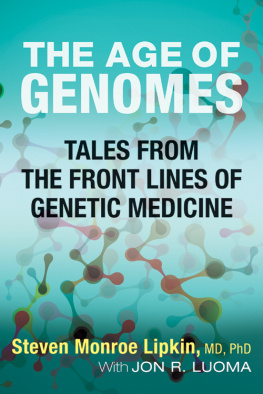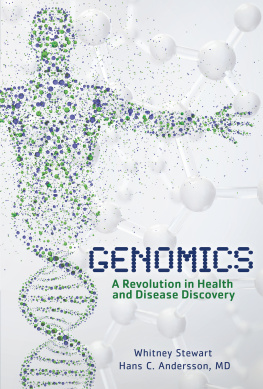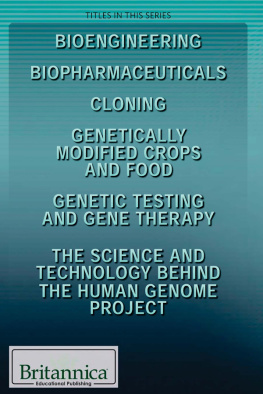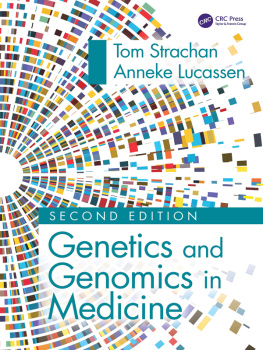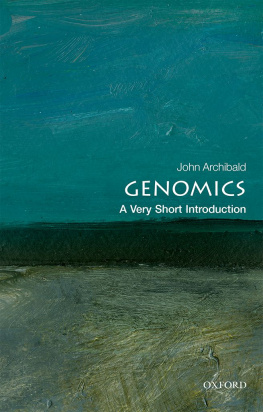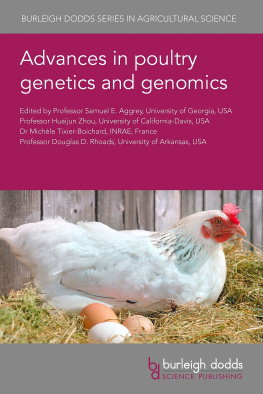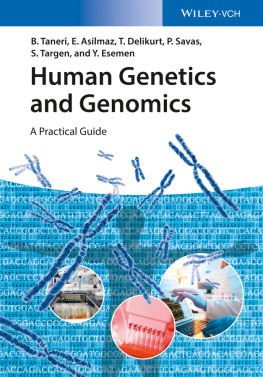To Gina, Rachel, Sophie, Alyson, Ethan, and Zoe, my wonderful family, for their great patience and help during the many hours I spent working on this book.
Introduction
In each of our beginnings was our personal genome, created when we were less than a single cell and with us every moment since. Our genome has helped define what we have, and havent, done with our lives. This precise DNA barcode, because of its enormous length and complexity, distinguishes each of us not only from the other eight billion people alive today on the planet, but also from each and every other of the twenty-something billion human beings who have ever lived since the dawn of humanity two hundred thousand years ago. Indeed, distinguishing each of us from every other living organism, whether flora, fauna, virus, or archebacteria for the past four billion years. What could be more personal than that?
Even when its hot outside, we dont walk around naked. People are typically squeamish about public nudity because they dont want every detail of their reproductive anatomy put out on display for all the world to see, and prudence prevails. But this particular modesty only runs skin deep. What is more profoundly revealing than being naked in a crowd? Today, certainly one answer to this question, mechanistically more than skin deep and down to the core of our very being, is the sequence of our very own genome.
However, even if we generally dont like getting naked in public, we will when theres a good reason to do so. One place people typically do this is their doctors office. We bare ourselves despite that slightly awkward feeling we have waiting there, exposed on the usually cold examining table, to allow our doctor to see our most intimate parts because we know this can help keep us healthy and so its worth the discomfort. Conversely, hiding some of these parts and refusing a doctors examination could cause a lot of pain, or worse, in the end. This is essentially the same reason why people decide to share this intimacy in silico by giving their personal genome information to their doctor. Such information provides a tool to help navigate us to a healthy one hundred and fifty years or so of life. This is not astrology: this is bona fide biological science. But what does it all add up to?
About twenty years ago, having all a persons DNA fully analyzed (commonly referred to as whole genome sequencing) cost about the same as an aircraft carrier. Now, it costs less than a Vespa and doesnt require a prescription. How incredible and astonishing is this era that we live in? Whole genome sequencing has become an established technology to identify previously undiagnosed diseases in patients and their families, to find missed drug targets in cancers, or even to embark on a journey of self-discovery about our roots and how we each became the person we are today. There are currently serious academic discussions promoting Generation XX/XYsequencing the genomes of all newborn American babies from a drop of heel bloodbeginning in the next decade or so. There are also thought leaders table thumping for ending the century-old practice of doctors diagnosing disease primarily by signs and symptoms and instead retooling medicine into a practice based on genetic and biochemical mechanisms of ailments. These are promising and profound changes.
It takes about twenty thousand or so genes to make a human being. Somewhat humbling, this is near the same number of genes as the mustard weed plant, and less than double the number of genes to make tiny fruit flies that we hardly notice. Yet, this is our personal instruction manual, and perhaps eventually the key to bringing us back from beyond the grave centuries after we have passed.
When geneticists and genetic counselors look at a persons genome, we look for specific changes, called mutations, that we think should be there. One can think of a strand of DNA as being something like a sentence, albeit laid out on the familiar twisting double helix. Individual letters in the words of that sentence comprise pairs of only four nitrogen-rich compounds: adenine, guanine, cytosine, and thymine, respectively represented by the letters A, G, C, and T. Mutations can be a misspelling by a single such letter (referred to as a base) of DNA, such as porcxpine instead of porcupine, or reshuffled letters (pucropine), and additions or losses can stretch for millions of bases. This code ultimately defines each of our personal destinies.
Think of all these genes as divisible into multiple distinct piles, somewhat like sorted dirty laundry. Into the first hamper of gene mutations go the relatively few select ones often referred to as actionable. Like stained clothes in your dirty laundry that need to be sorted out to go to the dry cleaners, the hamper of actionable gene mutations has the most precious and sought after contents. Actionable genes are the ones medicine can create a plan to fix, gene mutations with both a categorical imperative to inform patients what to do and a package insert telling doctors how to do it. If you have ten doctors in a room and ask them what we should do next with actionable gene mutations, all the hands go up in unison, each proudly and enthusiastically displaying medical literature about the best therapy for treating the genetic illness.
If we find a mutation in an actionable gene, the doctor and patient stand on a road looking out on the horizon. In front of them, the road bifurcates like the letter Y. There is a distinct choice of what can be done next. For example, the breast/ovarian cancer risk gene BRCA1, which spawned terabytes of journal articles and numerous clinical trials with guidelines about what the patients can decide to do (or not do, if they so choose) next to reduce their risk of developing cancer with surveillance imaging tests, chemopreventative drugs, or previvor surgery. These are the mutations that my patients anxiously hold their breath for, the ones we doctors (and the electronic medical record intelligent apps now monitoring and alerting us) will be drawn to first. These mutations are usually the reason why people go see a geneticist in the first place.
If a mutation in an actionable gene is found, a great deal can be accomplished, not only for the patient in front of you, but also for their kin, like water seeping deep down into the roots of a family tree forever into the future. After you articulate pros and cons of potential actions and anticipate reactions from the patient on what comes next, you have to discuss the what, how, and whenas well as whether, since the patient fully controls his or her genetic informationto contact the brothers and sisters, aunts and uncles, and children. An individuals choice whether or not to disclose personal genetic finding is always his or her own.
Occasionally, actionable gene mutations seem to emerge out of nowhere. These are often referred to as incidentalomas or (more recently) secondary findingsserendipitys evil twin. You go in looking for the etiology of hereditary colorectal cancer to detect tumors early and save a life and you find... Gaucher disease? Where in the world did that come from? The revelation comes without a history, but with hope to improve the familys future: you have discovered the seeds of a treatable disorder for which there exists enzyme replacement therapy, a clear actionable plan, but for which the person sitting in front of you has none of its signs or symptomsat least not yet? With this knowledge, you can prevent disease, pain, and suffering before it happens.

